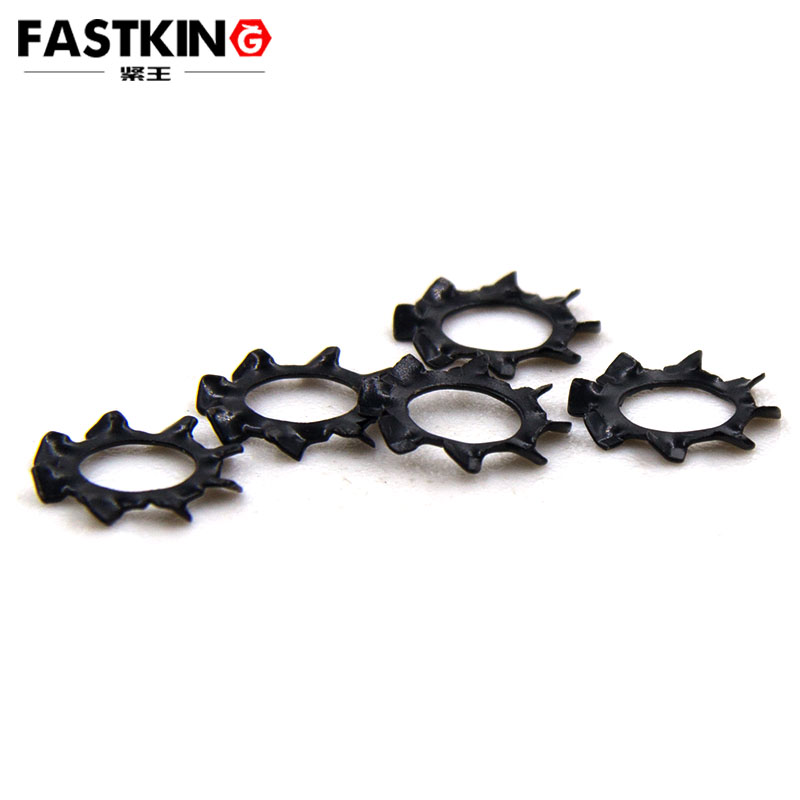- ZHUHAI JIALI HARDWARE CO.,LTD.
- +86-756-8586520
Environmentally friendly black zinc external serrated washer
- Product description:Outer tooth locking gasket anti loosening gasket
Grasping the in-depth characteristics of these three types of washers is crucial for achieving "precision selection and efficient fastening".
From the perspective of core structure and anti-loosening principles, the three types exhibit distinctly different design logics. The electrophoretic black anti-slip locking washer centers on a "dual anti-loosening" mechanism: its base material is mostly high-carbon steel (e.g., SAE 1070), and its surface undergoes electrophoretic black treatment to form an 8-15μm thick organic resin film. This film not only enhances wear resistance and rust resistance but also increases the friction coefficient (μ≈0.5-0.6) via the coating. Structurally, most models feature internal, external, or double-sided serrations; when tightened, these serrations embed into the connected component and the bolt head to form mechanical interlocking. Combined with the frictional force of the coating, this achieves "physical interlocking + friction enhancement" dual anti-loosening, offering strong anti-loosening stability and reversibility (reusable after disassembly).
By contrast, the external-tooth locking washer adopts a core design of "unidirectional tooth interlocking". The edge of the washer is equipped with sharp outward-facing serrations (usually 8-12 teeth, with a tooth height of 0.2-0.5mm). Its material is mostly low-carbon steel or stainless steel (e.g., 304), and its surface is often galvanized or passivated. When tightened, the external teeth incline in only one direction and embed into the surface of the connected component, forming unidirectional mechanical locking — allowing only bolt tightening. If the bolt tends to loosen due to vibration, the serrations will lock in the reverse direction to prevent loosening. However, its anti-loosening function is "unidirectional"; moreover, the serrations may damage the surface of the connected component after embedding, and the tooth shape is prone to deformation after disassembly, so it is generally for one-time use.

The spring lock washer (the most common type of anti-loosening washer) relies on "elastic deformation compensation" for anti-loosening. Its material is mostly 65Mn spring steel, its surface is mostly treated with black oxide, and its structure is "dish-shaped" or "wave-shaped". After installation, the washer is compressed by the bolt's pre-tightening force to generate elastic deformation, continuously applying axial elastic force to the bolt. This compensates for the loss of pre-tightening force caused by bolt vibration, thermal expansion, and contraction, thereby preventing loosening. Its anti-loosening principle depends on elastic force, with no mechanical interlocking structure and a relatively low friction coefficient (μ≈0.3-0.4). The anti-loosening effect is susceptible to deformation fatigue — the elasticity of the spring steel weakens after long-term use, leading to a significant decline in anti-loosening performance.
In terms of performance, the three types have their own advantages and disadvantages in anti-loosening stability, corrosion resistance, and applicability. In terms of anti-loosening stability, the electrophoretic black anti-slip locking washer has an obvious advantage: under a 10-500Hz vibration environment, when an M8 bolt is matched with this washer, it can still maintain more than 90% of the initial pre-tightening force after 10,000 vibration cycles. Due to its unidirectional interlocking, the external-tooth locking washer performs reasonably well in unidirectional vibration scenarios (e.g., conveyor equipment), but in multi-directional vibration scenarios (e.g., automobile chassis), the pre-tightening force retention rate is only 70-80%. Under high-frequency vibration, the elasticity of the spring lock washer tends to attenuate, with a pre-tightening force retention rate often lower than 60%, making it only suitable for low-vibration and low-load scenarios.
Regarding corrosion resistance, the electrophoretic black anti-slip locking washer, relying on its electrophoretic black coating, shows no red rust for 48-72 hours in the neutral salt spray test (ASTM B117), outperforming the external-tooth locking washer (which only resists red rust for 24-48 hours with galvanized treatment). If the external-tooth washer is made of 304 stainless steel, its corrosion resistance will improve (≥1000 hours in salt spray test), but the cost will also increase accordingly. Due to its common black oxide treatment, the spring lock washer has the weakest corrosion resistance, showing rust marks within 12-24 hours in the salt spray test. It needs to be used with rust-resistant bolts; otherwise, its elasticity is likely to be affected by rust.
In terms of scenario adaptability, the three types have clear application boundaries. The electrophoretic black anti-slip locking washer balances anti-loosening stability and reversibility, and its electrophoretic black appearance is aesthetically pleasing. It is suitable for scenarios requiring high anti-loosening performance, repeated disassembly, and emphasis on appearance, such as automobile chassis components (suspension, drive shaft), industrial control cabinets, and high-end home appliances (e.g., washing machine motors), especially suitable for medium-corrosion and medium-load environments.
Due to its unidirectional anti-loosening function and potential for damaging the workpiece surface, the external-tooth locking washer is more suitable for one-time fastening scenarios with moderate anti-loosening requirements and allowing slight damage to the connected component surface, such as furniture connectors, simple mechanical equipment (e.g., small water pumps), and temporary fixing devices. If made of stainless steel, it can also be used in slightly corrosive outdoor scenarios (e.g., fence fixing).
With its low cost (unit price of only 0.03-0.08 yuan for M8 specification) and simple structure, the spring lock washer is suitable for low-vibration, low-load scenarios with low anti-loosening requirements, such as ordinary motor end covers, internal component fixing of distribution boxes, and household tools (e.g., electric drill housings). However, its poor corrosion resistance and long-term stability make it unsuitable for high-intensity working conditions such as automobiles and heavy industry.
Overall, the electrophoretic black anti-slip locking washer is the preferred choice for "medium-to-high requirement scenarios", the external-tooth locking washer is suitable for "medium-requirement, one-time fastening scenarios", and the spring lock washer is a basic option for "low-cost, low-requirement scenarios". There is no absolute superiority or inferiority among the three; only by considering specific working conditions (vibration intensity, corrosion environment, load magnitude, and whether repeated disassembly is needed) can the optimal fastening effect be achieved, reflecting the core logic of "scenario-determined selection" in mechanical design.


